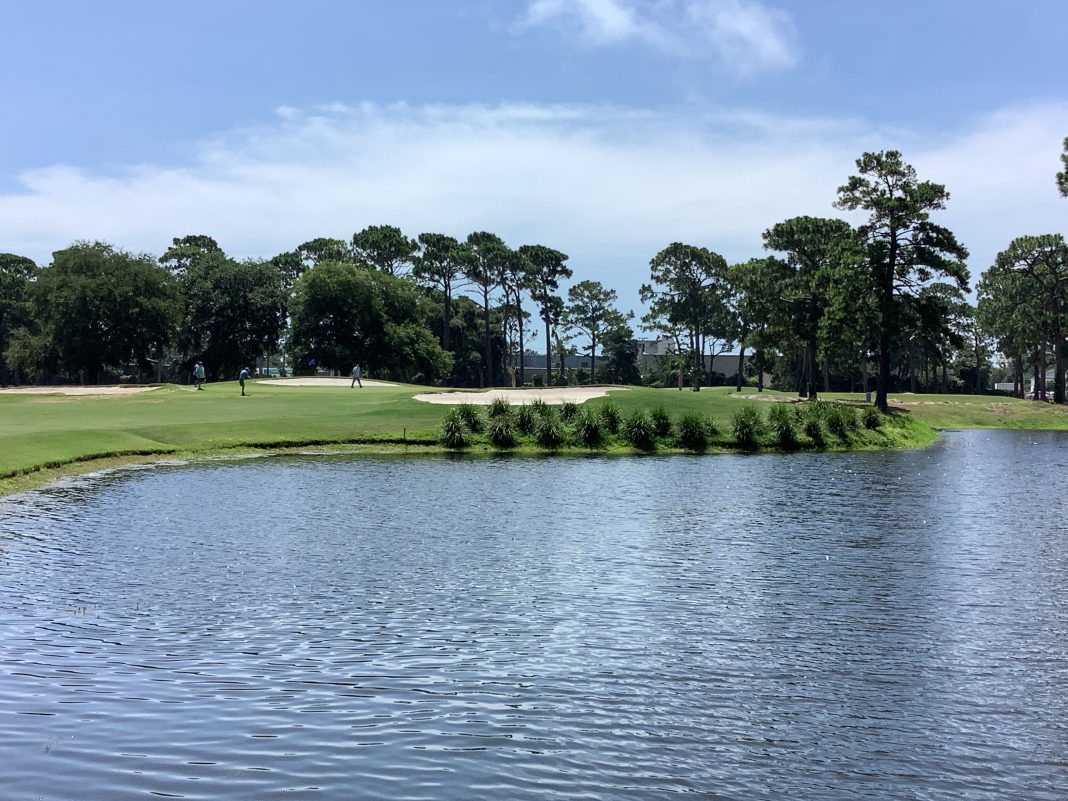After spending four years in maintenance at private golf clubs, Horry-Georgetown Technical College graduate Nic Sparks was offered a reclamation project at an old public course in North Myrtle Beach.
Intrigued by the opportunity to become a head superintendent for the first time and put his stamp on a property that had largely been neglected agronomically, he accepted the challenge.
Now nearly two years into the job, he has led a transformation of the 57-year-old Beachwood Golf Club, a 6,700-yard Gene Hamm design.
“Everything about this golf course has changed,” said Sparks, who is 28. “It has really been pedal to the metal since I got here. We’ve made a lot of big changes from the aesthetics of the golf course, the playability, and even the day-to-day operations. We’re going to continue to keep getting better.”

Returning to the Grand Strand
Sparks, a native of Blairsville, Georgia, worked at International World Tour Golf Links during his time in HGTC’s turf program, and also had a summer internship with the Landscapes Unlimited golf course construction company, working on courses that included Augusta National Golf Club – home of The Masters Tournament.
After graduation he worked at a pair of private clubs. He spent three years as the senior assistant superintendent at Waterfall Club in Clayton, Georgia, and a year as the senior assistant at Berkeley Hall in Bluffton before being contacted by Beachwood board of directors member Rick Elliott after responding to an online employment ad for a superintendent at an undisclosed course in North Myrtle Beach.
He said Elliott told him they had a vision for the future of Beachwood and thought Sparks would be a good fit, and he agreed to become the new super in August 2023.
Sparks knew he had his work cut out for him before being hired following a tour of the property.
“It was very overwhelming,” Sparks said. “I knew it was a lot of work. The property was very overgrown. . . . But I wanted something where I could leave a mark on it and build my reputation. I was interested in putting in the work and actually making a difference.”
He said the board and ownership group assured him the funds would be available to make the changes he deemed necessary to elevate the conditions and golfer experience.
“[Elliott] said we want to be competitive, and I told him if I’m going to put my name on something I want it to be great, and if we can share that vision I think this will be a great opportunity,” Sparks said. “I said as long as you give me resources and my hands aren’t tied, I can build a crew and we can build this thing up and get it back to where it needs to be.”
Elliott said the Beachwood board, led by president Carl Rust, is committed to reinvesting in the product.
“Carl and the board have opened up the checkbook to make sure the golf course has everything it needs and is back to where it was originally,” Elliott said. “. . . We’d rather keep the course in great shape, keep investing in the golf course and investing in the asset itself, because we believe in golf and think it’s such a wonderful sport, and we want to keep it viable in our community.”

Sparks was enticed by the idea that being at a public course would allow him to make the business more of a family affair, with his wife, Taylor, and 4-year-old daughter, Lennon, being able to come to the course for recreation.
“I knew it was going to be a lot of work, so being able to have them out here to go eat lunch, or for them to ride around and hit balls in the afternoon, or let my little girl go chase turtles [was important],” Sparks said. “You can’t do that kind of stuff at Berkeley Hall.”
Extensive improvements
The work that has been done, is being done and will continue to be done at Beachwood is extensive and labor-intensive. Much of the infrastructure remains from the 1968 opening.
He hired an all-new 10-person maintenance crew with the exception of the mechanic, who remained from the previous crew, and he has seven full- and three part-time workers.
General cleanup was needed at first. Sparks said he hauled off about four dumpsters full of old maintenance equipment and scrap metal that surrounded the maintenance shop, the clubhouse was nearly overtaken with bushes, and areas on the outskirts of holes and between holes were overgrown. Those areas are now cleared with pine straw, opening up views of several holes.

Sparks has strategically eliminated some trees to help growing conditions and said most of those trees were already dead or damaged. Because Beachwood has lost what Sparks believes approaches 1,000 trees over the years due to storms, he’s adding some trees for aesthetics and others for hole strategy purposes.
Many of the trees for aesthetics are palm trees, while pine trees and some hardwoods and ornamental trees such as Crape Myrtles and Dogwoods have been added.
Numerous native and waste areas have been added with ornamental grasses, plants, bushes and flowers, which include azaleas, amelias and magnolias.

Several tee boxes are being rebuilt and expanded, and all of them on par-3s have been completed. “We’ll expand them to meet modern-day expectations and modern-day play,” Sparks said.
Numerous areas have been re-grassed. “I don’t know how many trucks of sod I’ve laid, but it’s a lot,” Sparks said. “I’m taking out a lot of contamination, we’re regrassing and sodding collars.”
The maintenance shop was renovated and needed equipment was added, including a lift to work on maintenance machinery and vehicles, and grinders to sharpen mower blades.
Eradicating weeds has been a focus. “All the short grass is pretty good, it’s just the rough,” Sparks said. “We’re still trying to catch up with that. Weed maintenance is huge. That’s probably No. 1 for me.”
Mowing lines were established to clearly differentiate tees, fairways and rough. “Nothing was contoured,” Sparks said. “You couldn’t see the difference between tees and rough. There were no edges to anything.“
The course still has its original TifDwarf Bermudagrass greens, and Sparks said greens were rolling at about 6 on the Stimpmeter when he arrived. He said he has gotten them up to 10 and generally maintains them at 9 or faster, though he said “as long as they’re not at 7, speed is not as important as smoothness and trueness.”

A newly purchased deep tine aerator was used this summer to improve the health of the greens.
“The goal was to restore the course back to the architect’s intention, and really develop a high standard for conditioning,” Sparks said.
Many bunkers have been expanded to restore them back to their original size, bunker sand has been replaced, bunker edges have been reshaped and sodded in many cases, and three bunkers have been added. One is on a lake bank on the 17th hole to help stop balls from reaching the water, and two were added on either side of the fairway to accentuate the bend of the dogleg-left par-5 14th hole.

Drainage has been added in some areas and enhanced in others, with an emphasis on landing and approach areas, and new sprinkler heads have been installed to improve irrigation.
Sparks said tees, fairways, greens and the entire par-3s are overseeded in the winter.
“You have to put maintenance first or you’re going to get what you had, a horrible golf course,” Sparks said. “. . . It’s so hard to talk about all the changes because we’ve changed everything. With the vision that we see, we still have a lot of work to do, so if you come play Beachwood you’re going to see us out there working. We’re here every day to provide a quality product.”
All the work has been done without closing the course.
Beachwood has hosted more than 50,000 rounds per year in each of the past three years, but revenue from the rounds has been increasing in part because of the improved conditions and ability to charge for the improved product, though it can still be considered a bargain course in the market.

Aside from the course, Beachwood has offerings that some other courses lack.
Beachwood has a sizable range with grass and mats, and has teaching pros Jim Campbell, a PGA Life Member, and Trevor Muffley, a North Myrtle Beach native and pro since 2009, providing lessons.
A chipping and putting green is being added to the practice area.
Beachwood has consistency in leadership as head pro Kevin Lawson has been at the course for approximately two decades.
Al Cloyd’s Al’s Custom Golf club fitting and repair business is also there. Cloyd has a covered and nearly enclosed hitting bay with the latest technology for fittings, and a club repair building.
Noticeable improvements
The changes were evident to Jason Himmelsbach, who grew up playing the course after being assigned to it while he was in the Carolyn Cudone Myrtle Beach Junior Golf Program in the 1980s. He played the course Saturday for the first time in at least a couple decades.
“It’s better now than it was,” Himmelsbach said. “For it being my first ever experience in golf, and now having played in all these different countries, to come back and leave it thinking it’s a fun, well-maintained course is a plus for the course.
“The course is in good shape. The greens are good. You definitely notice the bunkers. They’re all edged and the sand was good. Even after the rain [from Tropical Storm Chantal] the sand was good. You can definitely tell they’re committed to keeping it nice.”

Himmelsbach, who sells golf packages, believes there’s a solid place in the market for courses like Beachwood when they’re cared for.
“Myrtle Beach still needs courses like that, a good solid course where you don’t want to spend $100,” Himmelsbach said. “As things have escalated it’s nice having the old-school courses that have been here. To have one that’s going to be in good shape like that, I think that’s a really good thing.”












